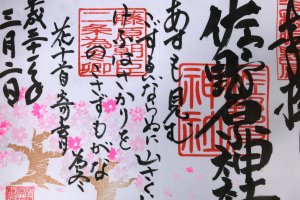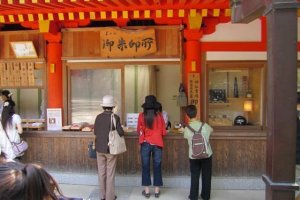Harajuku’s Meiji Jingu Shrine, Asakusa’s Senso-ji, and Kyoto’s Kiyomizu-dera, Kinkaku-ji and Fushimi Inari Taisha Shrine—these are some of Japan’s most iconic shrines and temples that are visited by tens of thousands of locals and tourists alike every year. Visitors tend to use a few typical methods to encapsulate their visits: taking photographs, buying omamori (amulets), uploading multimedia onto social media, or buying omiage (souvenirs). But there’s another way to immortalize your visits to these beautiful fixtures of Japanese culture—goshuin (seal stamps).
What is Goshuin?
Literally translated to ‘honorable red seal’, goshuin (御朱印) is a red stamp that can be obtained from Shinto shrines or Buddhist Temples in Japan.

Dating back as early as around 1300 years ago, the practice of goshuin is thought to have originated as proof of one’s devotion. Pilgrims would handwrite shakyo (Buddhist sutras) and dedicate them to Buddhist temples, and in exchange, receive a goshuin from the temple’s nuns and monks.

In modern times, the practice of collecting goshuin has changed slightly. Rather than copying and devoting sutras, visitors can pay a fee (usually ranging from ¥300 to ¥1000) or make a donation to a temple or shrine to receive a goshuin. Members of the younger generation have also been taking up collecting unique goshuin as a hobby, with many taking to social media to show off cute, seasonal or remarkably aesthetic goshuin from rarely-visited temples and shrines.

Then… what’s a Goshuincho?
Most goshuin are stamped on the pages of a book. These books, officially known as goshuincho (御朱印帳), serve as a kind of record or proof of faith. It houses evidence of one’s pilgrimages to various shrines and temples during their lifetime. These books are still used by goshuin collectors today, though they probably hold less spiritual significance to their users.

Goshuincho can be bought at shrines or temples directly, or at normal bookstores. If you decide to buy them at shrines or temples, you’ll find the kanji for goshuincho written on the front, while the name of the shrine or temple is written on the back, also in kanji. For example, the goshuincho pictured below is from Osaka’s Mizuma-dera, and the temple’s famous scenic spots are ornately embroidered onto the goshuincho’s cover.

Goshuincho that aren’t sold at shrines or temples tend to have covers that are either of the following three types: plain ones with simple print, extremely elaborately-designed ones, sometimes with hand-carved wooden covers, or unique, limited-time ones with funkier designs. For example, the below goshuincho was modeled after Utagawa Hiroshige’s adorable cat artwork.

Goshuincho typically come in two sizes: 18cm by 12cm, or 16cm by 11cm. They’re specifically made in these sizes to ensure that all temples or shrines’ goshuin can fit on the pages. The books are typically priced anywhere between ¥1500 to ¥3000, although those with extremely detailed designs are, as you might expect, much more expensive.
Let’s get your Goshuincho stamped!
You’ve got your goshuincho, now let’s go get it stamped! Once you’ve walked into the temple or shrine, look for the reception area. This is typically where you’ll see keychains, omamori and other services being sold. Near or in that building, you’ll find one of the following signs written in kanji: Goshuinjo (御朱印所), Shuinjo (朱印所), or Noukyoujo (納経所) at temples, and Goshuinjo (御朱印所), Juyojo (授与所), or Shamusho (社務所) at shrines.

If you can’t seem to see any of these signs, simply approach any of the temple or shrine staff and ask, ‘Goshuinjo wa doko desu ka? 御朱印所はどこですか?’–where is the goshuin-stamping location?–and they will direct you there.

Once you’ve found it, hand over your goshuincho, opened to an empty page, as well as the stamping fee (in cash) to the kannushi (servant of God) on shift, and they’ll get right to work on stamping the page and calligraphing in black ink. Depending on the temple or shrine, you may be able to choose from an array of designs: if that’s the case, simply point at the one you want.

During festivals and seasonal events, some shrines and temples prepare special goshuin in advance and hand them out as sheets of paper to visitors. You can glue these directly onto your goshuincho on your own. This was especially common at the height of COVID-19 as well, to prevent unnecessary cross-contamination.

At extremely popular shrines or temples or if the goshuin queue gets too long, shrine or temple staff may request you to leave your goshuincho with them while you stroll around the temple or shrine grounds. After a while, you can return to collect your goshuincho and pay the stamping fee. This is to prevent a long line from building up, and to ensure that visitors don’t get too bored standing around and waiting for their turn.
Rules to observe as you fill up your Goshuincho
Take note though, that there are a couple of easy rules to follow as you embark on your goshuin-collection journey.
1. Don’t give your goshuin or goshuincho away
As aforementioned, goshuin are believed to be blessings from God. Giving them away, especially giving a compiled book of goshuin away, is equivalent to actively and consciously giving away God’s blessing to you. This is seen as extremely rude and ungrateful behavior.
2. Don’t use your goshuincho for things other than collecting goshuin
Goshuincho are only meant to be used to collect goshuin. They should not be used as journals, diaries, or seen as normal notebooks.
3. Pay your respects at the temple or shrine before collecting a goshuin
The primary purpose of visiting a shrine or temple is to appreciate its deity, landscape, and architecture, not to collect goshuin.
4. Wait quietly and in an orderly manner when queueing for your goshuin
Remember that a shrine or temple is a place of worship. Even if the queue is long, remain respectful and aware of the atmosphere at such spiritual locations.
5. Do not take photographs of the kannushi unless explicit permission is given
Kannushi are not objects or exhibitions to marvel at; they are servants of God that are assigned to a job that they take pride in. If you would like to take a photograph or video of the calligraphy process, request for their permission first. Only proceed if their express approval is given.
6. Do not request designs from the kannushi
Each shrine or temple has their own unique designs for specific reasons. Even if a temple or shrine no longer offers a goshuin design that they had previously offered, it is rude to ask them to modify their current design for your own sake. Also, every kannushi’s calligraphy is different–even if you do not find that their handwriting fits your ‘aesthetic’, it is disrespectful to ask them to rewrite the goshuin until you are satisfied.
7. Take note that some shrines will not stamp a goshuincho that contains goshuin from temples, and vice versa
Some shrines and temples are stricter than others, and will not stamp your goshuincho if it contains a mixture of goshuin from shrines and temples. A sure-fire method to prevent your goshuincho from getting rejected is to have two separate goshuincho: one for temples, and one for shrines.
8. Prepare exact change, in cash, for the stamping fee
Most shrines and temples in Japan only accept cash. To prevent holding up the queue, it is recommended that you prepare the exact stamping fee, in cash, well before you reach the front of the queue.
Understanding Goshuin seals

Now you’ve finally got your first goshuin but… you’re not sure how to make heads or tails of it. Let’s run through the basic structure of a typical goshuin, using this example from Fukuoka’s Kushida-jinja.
1. Largest red stamp, placed in the center of the page
The largest red stamp contains the name of the shrine or temple. In this case, the kanji ‘櫛田神社’ is stamped, which translates to Kushida-jinja, the name of the shrine.
2. Smaller red stamp(s)
The smaller red stamp(s) symbolize the shrine or temple’s deity. In the photo above, the three hexagons represent Hakata’s three patron Gods, Amaterasu Omikami, Ohatanushi no Omikami, and Susano no Omikami, that the Kushida-jinja is dedicated to.
3. Main calligraphy in the center of the page
a. Largest calligraphy
The largest calligraphy writes out the name of the shrine or temple in Kanji, in this case ‘櫛田神社’ for Kushida-jinja.
b. Smaller calligraphy written to the sides of the largest calligraphy
In some cases, shrine or temple names may be longer than three to six characters. In this case, the kanji is split up, with the ‘main’ shrine or temple name written in a larger calligraphy, while the trailing or following kanji are written in a smaller size to either sides (or sometimes both) of the larger calligraphy. In the above example, the full name of the temple is ‘博多総鎮守櫛田神社’ (Hakata Souchinju Kushida-jinja) so ‘博多総鎮守’ (Hakata Souchinju) is written on the right side of the larger calligraphy.
4. Calligraphy to the left side of the page
This kanji represents the date of your visit to the shrine or temple. The format used is year xx of the xx era, xx month, xx day (xx xx年、xx月、xx日). In the photo above, 平成二十五年、七月、三十一日 is written, which translates to July 31st of year 25 of the Heisei era, i.e. 31 July 2013.
5. Calligraphy to the right side of the page
To the right you'll find the words ‘崇拝’ (すうはい, suuhai), ‘奉拝’ (ほうはい, houhai), ‘参拝’ (さんぱい, sanpai) or ‘遥拝’ (ようはい, youhai), meaning worship, adore, revere, etc.
Conclusion

We hope this guide has given you the inspiration and courage to start collecting goshuin! Though it’s still seen as an activity most commonly carried out by Japanese people, we believe that collecting goshuin can be fun and meaningful to tourists and travelers alike.
And if you’ve already started collecting goshuin and want to visit lesser-known shrines and temples and collect more unique goshuin, check out one of our community writer’s guide to pilgrimages.
Happy goshuin collecting!





























